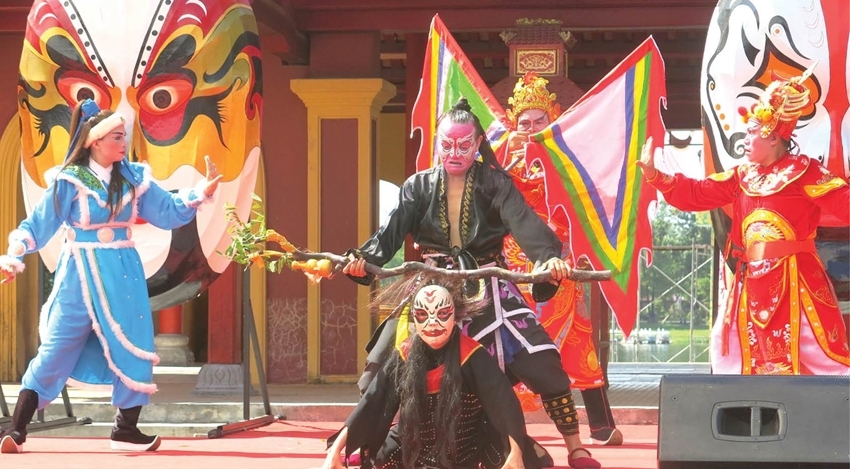 |
| Tuong masks are typical and special |
A work of painting
Born in a family of art, Excellent Artist La Thanh Hung is not only successful with many pieces of Tuong but also known as one of the few artists who keep the secrets of making masks for Tuong Hue. As a son of the deceased artisan La Chau, the last royal Tuong artisan of the Nguyen dynasty, at as early as 8-9 years old, Hung became an artist.
He is very passionate about makeup and can do it for himself. By observing makeup artisans, he grasps all the principles and techniques for each character in Tuong. Currently he is considered the only person who can remember and paint in detail masks for hundreds of characters in dozens of Tuong pieces.
According to La Thanh Hung, each character in Tuong wears a different mask with the three main colors: black, red, and white. Each mask represents the personality of each character. White color is for villains; red color is for heroic men; black color represents toughness, etc.
“When painting masks for Tuong, I always talk to myself that no matter how successfully the artists play, if their masks are wrong or not beautiful, then the whole play fails. Each mask is a work of painting depicting the character who is wearing it. The makeup artist is very crucial. He must know the characteristics of each mask for each character,” said La Thanh Hung.
The originality of Tuong masks is a key element which makes Tuong Hue valuable. Looking at the mask the audience know whether the character is an honest man or a flatter, and if he represents a good man or a bad man. Tuong mask makers must be skillful and experienced. They well understand the meaning of each pattern on the mask.
Conveying the unique beauty of Tuong
Tuong is an original traditional art of the Vietnamese people. Tuong appeared quite early. Especially Tuong was paid more attention to and reached its best in the Nguyen dynasty. Developing in a special historical and political context Tuong Hue has its own identities which only those who are knowledgeable about Tuong can recognize.
Tuong masks are typical and special. Mask making has been so far taught by words of mouth and imitation. Gradually due to the fact that some mask makers did not know well the unique significance of patterns, Tuong masks have lost their traditional identities. Few young artists today know mask-making techniques clearly and in detail.
According to Le Mai Phuong, head of the Applied Studies Bureau at Hue Royal Theatre, masks are the most important prop in Tuong which help convey the unique beauty of this traditional art form. Tuong masks are based on human faces in real life.
Skin colors in real life are represented in masks as white, black, red, yellow, etc. attached with typical meanings. White areas on masks represent muscles. Patterns on masks originate from folk symbols such as dragon, unicorn, turtle, phoenix which symbolize royalty, delicateness or power. Characteristics of each character are expressed in the eyes on the mask.
In order to introduce and honor the art of Tuong, the Royal Art Theater produced Tuong masks and introduced them to the public in the show named “Echos from the Past” at Hue Festival 2022. It was the first time there had been a parade on the streets honoring the lively colorful beauty of Tuong costumes and masks.
The highlight of the show was that the actors and actresses played the role of 100 Tuong characters in costumes and masks of different types, creating a colorful provoking vivid scene depicting an art form popular in the past. Masks showed a diversity of colors, shapes and characters of different ages and genders with different personalities. Most of the masks were made by La Thanh Hung.
This year, the show “Echos of the Past” about Hue Tuong will be continued at Hue Festival 2023. The show makers want to create an accessible vivid visual product, contributing to honoring the Vietnamese art as a practical way to preserve, conserve and promote the art heritage of the country.